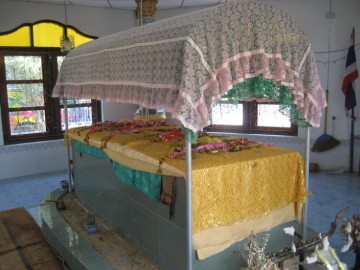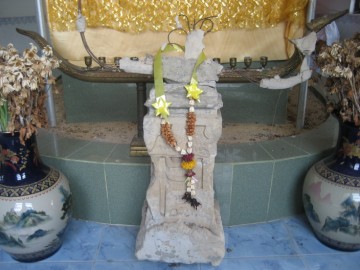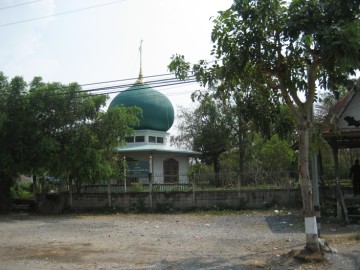| KHU CHAM CEMETERY AND TOMB OF CHULA RACHAMONTRI IV |

| Text & photographs by Tricky Vandenberg - February 2010 |
| The Tomb of the 4th Chula Rachamontri named "Chen" is located off the city island in the southern area of Ayutthaya in Samphao Lom sub-district (the capsized junk sub- district) on an ancient Muslim graveyard called Chao Kun Khu Cham. The cemetery is situated on the west bank of the Khu Cham canal in an area largely populated by Muslims. Chen, a Persian Muslim, was the Phraya Chula Rachamontri and Sheikh'ul Islam in the reign of King Suriyamarin (r. 1758-1767). He was the last Chula Rachamontri (1) of the Ayutthayan era. His father Jai, a royal page under King Narai, raised to the rank of Chao Phraya Phet Pichai in the reign of King Borommakot (r. 1733-1758) and was commander of the Cham volunteers (2) as well as the Japanese volunteer forces. He converted to Buddhism on a pilgrimage of King Borommakot to the Phrabat in Saraburi in 1750. His younger brother, Sen, became Chao Phraya Maha Sena or Head of the Ministry of Defense in the reign of King Suriyamarin. (3) [2] The youngest brother, Nu, was a director of the royal pages with the title of Chao Meuan Wai Woranat at the time Ayutthaya was sacked by the Burmese in 1767 (4). [3] Chen, remained faithful to Shi’ism. He was married to Konthong and they got a son, Konkaew (5). Their family home stood at the mouth of the Khu Cham canal. Chen obtained first the rank of Phraya Wichit Narong and was later promoted to Phraya Chula Rachamontri. The Shi’ite Muslim family, belonging to the Sheik Ahmad family branch, were as thus quite powerful in the Siamese administration of that time and monopolized the Department of Western Maritime Affairs. [2] Chen was also given charge of the Royal Treasury, but apparently not given the title of Chao Phraya Phra Khlang, which usually came with this position. [5] The Chula Rachamontri controlled from the 17th century onwards the Department of Western Maritime Affairs known in Siam as the Krom Tha Khwa - free translated the "Ministry of the Harbour of the Right". It was one of the four ministries (6) reorganized during the 1610s with the assistance of two prominent Muslim merchants Sheikh Ahmad and Muhammad Said from Persia, and employed by the Ayutthayan Kings to maintain Ayutthaya's status of as a profitable center for trade. The new structural division placed all areas that were of primary concern to Muslim traders, within a single department, encompassing all the ports on the northern and eastern rim of the Indian Ocean, as well as the Muslim trading centers. The Krom Tha Khwa became traditionally led by a Muslim minister and was essentially the Kingdom’s method to engage profitably with the Muslim trade networks throughout Asia. [1] The Krom Tha Khwa was a commerce and foreign communication section under the Krom Phra Khlang (the Department of Trade and Treasury), with responsibility for commerce, the merchant marine, and foreign affairs. [2] The Chula Rachamontri, established since the reign of King Songtham (r. 1610/1611- 1628), was at the same time the leader of the Muslim community, adviser to the King on Muslim matters and responsible for the settling of disputes among foreigners other than Chinese. [5] After the fall of Ayutthaya in 1767 and the set up of the new Siamese capital at Thonburi under King Taksin, Chen returned to his family home at the mouth of Khlong Khu Cham in Ayutthaya. He died of old age. Chen, the 4th Chula Rachamontri and last of the Ayutthaya period, has his mausoleum on the ancient Chao Kun Khu Cham Muslim cemetery, the burial ground of many Muslims of the Ayutthaya era (presently in very poor condition). Locals stated that the Muslim cemetery was build upon the ruins of a Buddhist monastery, called Wat Thong. (7) Some shattered brickwork is found in situ around the burials (the place could indeed be a brick mound), but is impossible to determine at first sight that those bricks belonged to the said temple. Phraya Boran Rachathanin indicated a monastery with the name of Wat Thong on his map drafted in 1926 in this area, but he put the structure at the mouth and on the east bank of the Khu Cham canal. Footnotes: (1) Thipakorawong states that Chula Rachamontri compounds of an Arabic word "shura" means an Islamic council and a Sanskrit word "montri" means a King’s counselor so that Chula Racha Montri means the King’s Muslim counselor. He was the head of Muslims in Thailand as Sheikh'ul Islam. [1] (2) The Krom Asa Cham (Cham Volunteer Corps) was a division of the Ministry of Defense with the Phraya Rachawangsan as the division chief (Chao Krom), in charge of the Cham volunteers consisting of Muslims of Cham and Malay descent. [2] (3) Ref [2] - Page 51 states that also Sen became a Buddhist. - Buddhism was used during the Ban Phlu Luang period - starting with King Petracha (r. 1688-1703) - to create a sense of identity and unity within the Siamese kingdom. Some of Sheikh Ahmad’s descendants in the Siamese bureaucracy probably worried about this situation, effecting their stability (not belonging to the core group), and sought an escape in converting to Buddhism. After Phraya Phetphichai (Jai) became a Buddhist, he and his family succeeded in re-establishing their power and roles in the Siamese administration. - Sen's son (with his second wife) Bunnag became the progenitor of the Bunnag family, playing a vital role in administering the Siamese kingdom from the early Ratanakosin period until the 1880s. [5] (4) In the royal pages, there were four directors (jang wang) immediately under the department head who was invariably a royal relative. These four had the title of Chao Mun, with a Sakdina of 1000, and were addressed colloquially as Phra Nai. The four were: Sanphet Phakdi, Si Sorarak, Samu Jairat, and Wai Woranat. [4] (5) His son, Konkaew, was appointed to the position of Phraya Chula, the first Chula Rachamontri in the Ratanakosin period, by King Rama I. [2] (6) The three others were the Department of General Administration, Appeals and Records, the Department of Royal Warehouses and the Department of Eastern Maritime Affairs and Crown Junks. [6] (7) In this case the cemetery should date from the post-Ayutthaya period. Wat Thong was probably used by the Burmese as a war position, and as thus evacuated by the Buddhist clergy. The monastery must have been seriously damaged either in the sieges of 1760 or 1766-1767. References: [1] Book of Multifarious Duties - Bangkok: Khurusapha. (In Thai) - Chao Phraya Thipakorawong(1979). [2] The Shi’ite Muslims in Thailand from Ayutthaya Period to the Present - Julispong Chularatana. [3] http://www.bunnag.in.th - data retrieved on 19 February 2010. [4] The story of Khun Chang, Khun Phaen - Chap 13. [5] History and Politics of the Muslims in Thailand - Thanet Aphornsuvan - Thammasat University. [6] Muslim Influences in Seventeenth Century Ayutthaya: A Review Essay - Peter Hourdequin. |






| (Entry of Khu Cham cemetery) |
| (The Mausoleum of Chula Rachamontri IV) |
| (The Mausoleum of Chula Rachamontri IV) |
| (The tomb of Chula Rachamontri IV) |
| (The old tombstone of Chula Rachamontri IV) |
| (Old bricks in situ) |
